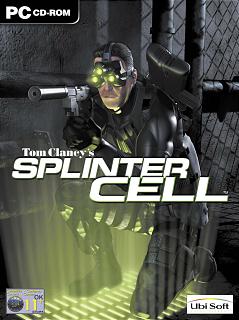Games Database
PC
Adventure
View all (28) >>
| Also for: | PS2, Xbox, GameCube | ||
| Viewed: | 3D Third-person, floating camera | Genre: | Adventure Strategy: Stealth |
| Media: | CD | Arcade origin: | No |
| Developer: | Ubisoft Montreal | Soft. Co.: | Ubisoft |
| Publishers: | Ubisoft
(GB) |
Released: | 28 Feb 2003
(GB) |
| Ratings: | 11+ | ||
| Accessories: | Control Pad | ||
Summary
The hype surrounding the Xbox version of Splinter Cell has now died down and, something that always happens following the release of a much-anticipated title, we've seen it, played it and now take all its exceptional qualities for granted. The game's stunning visuals have raised the benchmark, along with our expectations, and now we demand even more from a game. Well, that can now be satisfied with this release for the PC, which delivers the same stealth 'em up action, with slicker visuals, higher resolution and even greater use of the game's trademark luscious lighting. Oh, and a slightly different control system.
Taking control of one Sam Fisher - the best field-operative of the secretive 'Black-Ops' NSA sub-agency Third Echelon - players are sent to execute desperate missions as the government's last resort. Missions such as infiltrating CIA headquarters, seizing critical intelligence and destroying threatening data and equipment are pretty much run-of-the-mill to this guy, so players really have their work cut out. The main objectives are to remain undetected, neutralise every enemy, and exit without a trace.
The emphasis is most definitely on the stealth side of things here, with the main character having access to a massive array of nimble moves and abilities. Diving somersaults, hanging from ledges, peeking around corners, and even shinning up drainpipes are all required if one is to remain undetected. The environments throughout Splinter Cell are all highly interactive, with players able to make use of any objects lying around, shoot out any lights, and take advantage of shadows.
Provided you've got the graphics card power, the game really does look pretty tasty. Dynamic lighting and shadowing, Vertex shaders, volumetric lighting and texture rendering all add up, bringing the environments to life. But it is the lighting that is most notable. Every light in the game has a simulated source, which behaves realistically, casting shadows and reflecting appropriately. And it's these shadows you need to control and use to your advantage if you're to remain undetected.
One of the only other key differences between this and the Xbox version is the control method. A key element to the game is the control of the speed (and therefore loudness) of Sam, which was achieved rather easily via the left thumbstick. In the PC version, which uses its typical keyboard and mouse control method (W,A,S,D, etc.) speed is controlled using the mouse wheel, toggling between four degrees of speed. This can be quite tricky to master at first and can cause a few problems when jumping long distances and you forget to set the speed to full, but is soon mastered and can, at times, feel like more of an improvement over the original.
Which brings us to an ideal summary for the game. There's no denying the fact that the Xbox version is an exceptional title. This version is even better.
Taking control of one Sam Fisher - the best field-operative of the secretive 'Black-Ops' NSA sub-agency Third Echelon - players are sent to execute desperate missions as the government's last resort. Missions such as infiltrating CIA headquarters, seizing critical intelligence and destroying threatening data and equipment are pretty much run-of-the-mill to this guy, so players really have their work cut out. The main objectives are to remain undetected, neutralise every enemy, and exit without a trace.
The emphasis is most definitely on the stealth side of things here, with the main character having access to a massive array of nimble moves and abilities. Diving somersaults, hanging from ledges, peeking around corners, and even shinning up drainpipes are all required if one is to remain undetected. The environments throughout Splinter Cell are all highly interactive, with players able to make use of any objects lying around, shoot out any lights, and take advantage of shadows.
Provided you've got the graphics card power, the game really does look pretty tasty. Dynamic lighting and shadowing, Vertex shaders, volumetric lighting and texture rendering all add up, bringing the environments to life. But it is the lighting that is most notable. Every light in the game has a simulated source, which behaves realistically, casting shadows and reflecting appropriately. And it's these shadows you need to control and use to your advantage if you're to remain undetected.
One of the only other key differences between this and the Xbox version is the control method. A key element to the game is the control of the speed (and therefore loudness) of Sam, which was achieved rather easily via the left thumbstick. In the PC version, which uses its typical keyboard and mouse control method (W,A,S,D, etc.) speed is controlled using the mouse wheel, toggling between four degrees of speed. This can be quite tricky to master at first and can cause a few problems when jumping long distances and you forget to set the speed to full, but is soon mastered and can, at times, feel like more of an improvement over the original.
Which brings us to an ideal summary for the game. There's no denying the fact that the Xbox version is an exceptional title. This version is even better.















